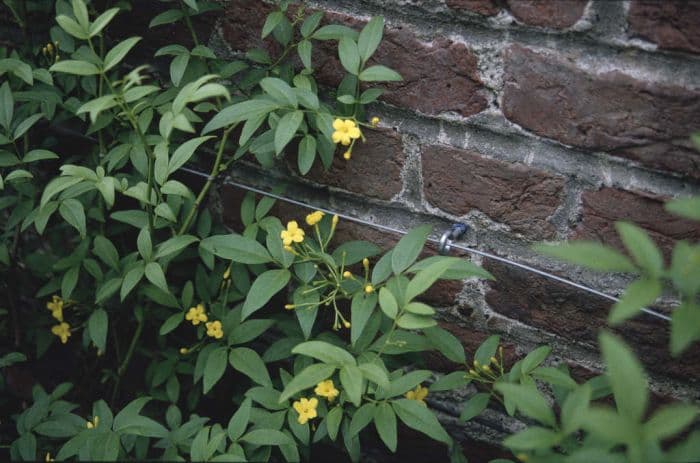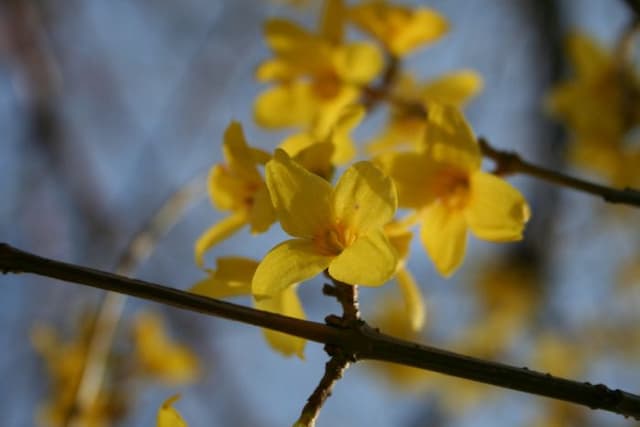Italian Yellow Jasmine Jasminum humile 'Revolutum'

ABOUT
Italian jasmine, as commonly referred to, 'Revolutum' offers a visual delight with its abundance of cheerful yellow flowers. Each bloom displays a charming, open-faced form, exposing the yellow petals that radiate around a central hub of prominent stamens, offering a friendly, inviting appearance. The plant has a graceful structure, with slender branches that arch and spread outward, covered in bright green leaves. These leaves present themselves as simple oval shapes, with a glossy shine and smooth edges that provide a lush backdrop to the radiant flowers which appear more abundantly during the warmer months of the year. The foliage is evergreen, lending a year-round vibrancy to the plant's form. Blooms exude a gentle fragrance that is subtle yet inviting, contributing to the plant's sensory appeal. Overall, Italian jasmine exhibits a charming and picturesque display of color and form, making it a beloved choice for gardeners seeking to add a touch of sunny yellow and evergreen beauty to their landscapes.
About this plant
 Names
NamesFamily
Oleaceae
Synonyms
Italian Yellow Jasmine, Yellow Jasmine
Common names
Jasminum humile var. revolutum, Jasminum revolutum.
 Toxicity
ToxicityTo humans
Italian jasmine is not commonly listed as a toxic plant to humans; however, it is still advisable to exercise caution and avoid ingesting it. While not considered highly poisonous, consuming this plant may cause mild gastrointestinal irritation or discomfort. If you suspect poisoning, consult a healthcare professional for advice.
To pets
Italian jasmine is not commonly known to be toxic to pets. However, as with any non-food plant, it is still possible that some animals could experience mild stomach upset if they ingest parts of the plant. It is always best to prevent pets from eating ornamental plants and to monitor them for signs of illness. If you notice any concerning symptoms after your pet has ingested this plant, please contact your veterinarian.
 Characteristics
CharacteristicsLife cycle
Perennials
Foliage type
Evergreen
Color of leaves
Green
Flower color
Yellow
Height
5-10 feet (1.5-3 meters)
Spread
5-7 feet (1.5-2.1 meters)
Plant type
Shrub
Hardiness zones
7
Native area
Himalayas
Benefits
 General Benefits
General Benefits- Aesthetic Appeal: Its bright yellow flowers add a vibrant splash of color to gardens and landscapes.
- Fragrance: The flowers emit a subtle, pleasant scent that can enhance the sensory experience of a garden.
- Attracts Pollinators: The blossoms attract bees, butterflies, and other beneficial pollinators, supporting local ecosystems.
- Privacy Screen: When planted in rows or hedges, Italian Jasmine can provide privacy and reduce noise pollution due to its dense foliage.
- Low Maintenance: It is relatively easy to care for, requiring minimal upkeep once established.
- Drought Tolerance: Once established, it has good drought tolerance, making it suitable for xeriscaping or water-wise gardens.
- Year-Round Interest: With its evergreen leaves, it provides visual interest throughout the year, even when not in bloom.
- Versatility in Landscaping: It can be used for a variety of landscaping purposes, including borders, walls, and trellises.
 Medical Properties
Medical Properties- This plant is not used for medical purposes.
 Air-purifying Qualities
Air-purifying QualitiesThis plant is not specifically known for air purifying qualities.
 Other Uses
Other Uses- The yellow jasmine can be used as a natural dye source for fabrics, imparting a light yellow hue to textiles.
- In landscaping, it can serve as an effective ground cover plant due to its spreading habit and dense foliage.
- This plant is sometimes used in perfumery for its sweet fragrance, as part of a bouquet of scents in a perfume composition.
- The essential oil extracted from the yellow jasmine flowers is occasionally used in aromatherapy for its calming and uplifting properties.
- Due to its attractive appearance, the yellow jasmine can be used in ornamental floral arrangements and as cut flowers in bouquets.
- Some cultures use the flowers as a natural offering in religious and spiritual ceremonies.
- The wood of the yellow jasmine is sometimes used in small woodworking projects, like crafting musical instruments or intricate carvings.
- In horticulture, the plant can be propagated as rootstock for grafting more delicate jasmine varieties.
- The yellow jasmine’s dense foliage can provide shelter and nesting opportunities for various bird species in a garden ecosystem.
- Certain parts of the plant, such as stems and leaves, can be used for educational purposes to study plant growth and morphology.
Interesting Facts
 Feng Shui
Feng ShuiItalian jasmine is not used in Feng Shui practice.
 Zodiac Sign Compitability
Zodiac Sign CompitabilityItalian jasmine is not used in astrology practice.
 Plant Symbolism
Plant Symbolism- Love: Jasmine flowers are often associated with love and romance due to their intense and alluring fragrance, which is believed to attract and captivate.
- Purity: The delicate white blossoms of many jasmine varieties symbolize purity and innocence, often used in ceremonies such as weddings to represent the pure bond between partners.
- Beauty: Jasmine is also a symbol of beauty, both due to the intricate structure of the flowers and the beauty they add to their surroundings with their presence.
- Femininity: The sweet and delicate nature of jasmine flowers has traditionally been associated with femininity and the soft, gentle qualities often attributed to it.
- Sensuality: The heavy and sweet scent of jasmine flowers can be intoxicating and is often connected with sensuality and intimacy, hinting at deep desires and emotions.
 Water
WaterItalian Jasmine requires consistent moisture, especially during the growing season. It should be watered when the top inch of soil feels dry to the touch, which may be approximately once a week, depending on the climate and weather conditions. Use room temperature water and apply it directly to the soil, avoiding wetting the foliage, to prevent fungal diseases. In terms of amount, during each watering, use about 1 gallon for outdoor plants or enough to ensure the water reaches the roots without causing standing water. Water less frequently during the dormant winter months, allowing the soil to dry out more between waterings.
 Light
LightItalian Jasmine thrives best in full sunlight to part shade. It should be placed in a spot where it receives at least 4 to 6 hours of direct sunlight daily, but in areas with hot summers, some afternoon shade will help protect the plant from intense heat. An eastern or western exposure is ideal, providing a balance of light and moderate temperatures.
 Temperature
TemperatureItalian Jasmine prefers warm conditions and does well in a temperature range of 60 to 75 degrees Fahrenheit. It can tolerate minimum temperatures down to about 20 degrees Fahrenheit but should be protected from frost. Avoid placing it in areas prone to sudden temperature drops or cold drafts.
 Pruning
PruningPrune Italian Jasmine after flowering to maintain the desired shape and to encourage bushier growth. Remove any dead or damaged branches, and cut back overgrown stems to encourage new shoots. It's best to prune in late spring or early summer, immediately after the bloom period, which allows time for new growth that will produce next year's flowers.
 Cleaning
CleaningAs needed
 Soil
SoilItalian jasmine thrives best in well-draining soil enriched with organic matter; a mix of loam, peat, and sand is ideal. A pH of 6.0 to 7.5 promotes healthy growth.
 Repotting
RepottingItalian jasmine should be repotted every two to three years to refresh the soil and encourage continued growth.
 Humidity & Misting
Humidity & MistingItalian jasmine prefers average to high humidity levels but is adaptable to various indoor environments as long as it's not too dry.
 Suitable locations
Suitable locationsIndoor
Place in bright, indirect light and keep soil consistently moist.
Outdoor
Plant in sun or partial shade; shelter from strong winds.
Hardiness zone
7-10 USDA
 Life cycle
Life cycleThe Italian Jasmine (Jasminum humile 'Revolutum') begins its life cycle when a seed germinates in well-draining soil during the warm season. Emerging as a seedling with basic leaf structures, it rapidly enters the vegetative stage, where it develops a more robust root system, stems, and foliage. It reaches maturity and begins the flowering stage after a few years, usually in late spring to summer, producing fragrant yellow flowers that attract pollinators. Post-pollination, the plant may produce small black berries as part of its reproductive stage, containing seeds for dispersal. The Italian Jasmine is a perennial, which allows it to go into a period of dormancy during colder months, shedding leaves in some climates while in others it may retain foliage year-round. Over its lifespan, which can be several decades in ideal conditions, the plant will repeat the flowering and dormancy cycle annually.
 Propogation
PropogationPropogation time
Spring-Early Summer
The most popular method of propagation for the Italian jasmine (Jasminum humile 'Revolutum') is by semi-ripe cuttings. This method is typically done in summer, when the plant’s growth is semi-ripe—neither too soft nor too woody. Cuttings about 4 to 6 inches long are taken from healthy stems. The lower leaves are removed, and the base of the cutting is dipped in rooting hormone powder to encourage root development. The prepared cuttings are then inserted into a pot containing a mix of peat and perlite or sand to provide good drainage. The pot is kept in a warm, shaded place, ensuring the soil remains moist but not waterlogged until roots are established, which can take several weeks. Once rooted, cuttings can be transferred to individual pots and eventually planted out.
![Forsythia [Marée d'Or]](/_next/image?url=https%3A%2F%2Fplants-admin.emdemapps.com%2Fimages%2Fplants%2F%2Fimages%2F604b5d7568293.png&w=640&q=75)








![Lilac [Boomerang Dark Purple]](/_next/image?url=https%3A%2F%2Fplants-admin.emdemapps.com%2Fimages%2Fplants%2F%2Fimages%2F607ea3ef9ba0a.jpg&w=640&q=75)